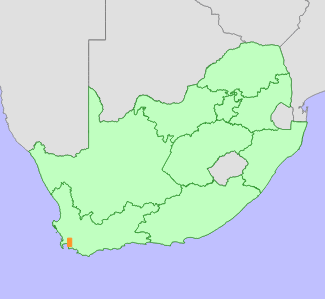|
Scientific Name | Erica abietina L. subsp. perfoliosa E.G.H.Oliv. & I.M.Oliv. |
Higher Classification | Dicotyledons |
Family | ERICACEAE |
Common Names | Jonkershoek Golden Heath (e) |
National Status |
Status and Criteria | Vulnerable D2 |
Assessment Date | 2012/08/06 |
Assessor(s) | L. von Staden & D. Raimondo |
Justification | This localized subspecies (EOO 11 km²), has been fragmented by habitat loss to timber plantations, which has caused 35% habitat loss in the past, but over a period longer than the past three generations, and the threat has ceased. It is still locally common, and some plants are potentially threatened by habitat loss to erosion and too infrequent fire. |
Distribution |
Endemism | South African endemic |
Provincial distribution | Western Cape |
Range | Jonkershoek Valley, Stellenbosch. |
Habitat and Ecology |
Major system | Terrestrial |
Major habitats | Boland Granite Fynbos |
Description | Moist, lower south to southwest facing granite slopes. |
Threats |
| Threatened in the past by habitat loss to timber plantations, this threat has however ceased as timber plantations are no longer expanding. Some plants occurring on small roadside cuttings between plantations are potentially threatened by erosion (R.C. Turner and E.G.H. Oliver pers. obs.) Some isolated fragments may be affected by too infrequent fire - this subspecies is a reseeder, requiring fire to regenerate. |
Population |
This is a very localized subspecies, it was quite likely formerly one large subpopulation occurring across the lower granite slopes of the Jonkershoek Valley, but the population has been fragmented by habitat loss to timber plantations. The plantations were established in the 1940s to meet increased demand for timber during WWII (Pistorius and Harris 2004), and about 35% of Boland Granite Fynbos in the Jonkershoek Valley is transformed. Timber production is however no longer a viable industry in the Western Cape and it is estimated from land cover data that no new plantations have been established since the 1990s. This subspecies is still locally common (Oliver and Oliver 2002) and is not suspected to be declining.
|
Population trend | Stable |
Assessment History |
Taxon assessed |
Status and Criteria |
Citation/Red List version | | Erica abietina L. subsp. perfoliosa E.G.H.Oliv. & I.M.Oliv. | CR B1ab(ii,iii,iv,v)+2ab(ii,iii,iv,v) | 2012.1 | | Erica abietina L. subsp. perfoliosa E.G.H.Oliv. & I.M.Oliv. | CR B1ab(ii,iii,iv,v)+2ab(ii,iii,iv,v) | Raimondo et al. (2009) | |
Bibliography |
Oliver, E.G.H. and Oliver, I.M. 2002. The genus Erica (Ericaceae) in southern Africa: taxonomic notes 1. Bothalia 32(1):37-61.
Pistorius, P. and Harris, S. 2004. 138 Jonkershoek Plantation. http://www.stellenboschheritage.co.za/wp-content/uploads/138_Jonkershoek_Plantation.pdf. Downloaded on 6 August 2012.
Raimondo, D., von Staden, L., Foden, W., Victor, J.E., Helme, N.A., Turner, R.C., Kamundi, D.A. and Manyama, P.A. 2009. Red List of South African Plants. Strelitzia 25. South African National Biodiversity Institute, Pretoria.
|
Citation |
| von Staden, L. & Raimondo, D. 2012. Erica abietina L. subsp. perfoliosa E.G.H.Oliv. & I.M.Oliv. National Assessment: Red List of South African Plants version 2024.1. Accessed on 2025/10/24 |
 Comment on this assessment
Comment on this assessment

